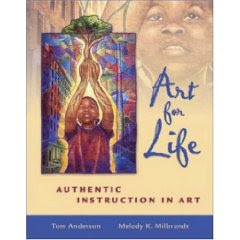Hathaway, N. (2008, September). 10 teaching and learning strategies in a choice-based art program. Arts & Activities. Retrieved November 1, 2009 from http://teachingforartisticbehavior.org/articles.html
“This system (a choice-based art program) honors individual learning styles and preferences, enabling children to work from their own strengths and interests and to draw on prior knowledge and experience.”
“Students may work alone or with peers, may “specialize” or may sample from a wide array of options. Students can persist with one project over many weeks, or try a variety of activities during a single class period. In this way, multiple learning styles and preferences are served.”
1. TEACHER-DELIVERED WHOLE-GROUP MINI-LESSON
“Most classes begin with a brief (five-minute) lesson—a demonstration of a new material or technique or an introduction of a new artist or style.”
“Often, original art (student or adult) is viewed and discussed, as are art reproductions or video clips.”
“Introducing topics this way assures that standards are addressed for all students.”
“Since the classroom is set up for students to access on their own, they can think about what they’d like to do ahead of time and arrive to class ready to work.”
2. TEACHER-DELIVERED SMALL GROUP LESSON
“Sometimes clusters of students have similar needs or interests, or work together on a single project, dividing and sharing the work. When this occurs, specific lessons can be designed and targeted to support this type of learning in a small group setting.”
“Organic groupings of this kind benefit students with varied abilities but similar interests; in essence, this is differentiating activities by student interest without regard to ability.”
3. TEACHER-DELIVERED INDIVIDUAL LESSON
” By noticing individual student art direction, the teacher can target lessons to support individual inquiry and pursuit. Noting and illustrating ties between student art and the art of others, across time and across cultures, the teacher can address art history and aesthetics in a way that is personally meaningful.”
4. INFORMAL PEER-TO-PEER TEACHING
“Often a student becomes an expert with a certain material or procedure and can ‘peer coach’ students with less developed skills.”
“Peer teaching also provides opportunity for classroom leadership.”
5. STUDENT “EXPERTS” TEACHING WHOLE GROUP
“Creating a ‘community of artists’ is an important goal in a choice-based art program. Recognizing what each artist has to offer the community is an important role for the teacher to embrace.”
6. CLASSROOM AS ‘SILENT LESSON PLAN/TEACHER’
“The classroom can be set up in numerous distinct ‘centers’ or ‘studios,’ each appointed with the materials and tools needed to make art. Here students can also find related references and resources (books, prints, examples of student work, etc.).”
“’Menus’ are created and displayed, describing procedures for setup and cleanup, or other essential information.”
“These centers include written information, pictographs and real art objects, all of which help get necessary information across to students with various learning predispositions.”
“Students who use and maintain learning centers feel a sense of ownership and control in the classroom.”
7. GUEST EXPERTS
“Exposure to adults passionate about their own art informs and supports the work done in the classroom, broadens horizons and presents new possibilities.”
8. FIELD TRIPS
“Planning trips to art museums, events and galleries heightens awareness and exposes students to the greater world of art.”
9. INDIVIDUAL INQUIRY
“Through individual exploration, practice, research and presentation, students may act as their own guide and teacher.”
“While exposure to a variety of options exists in a choice-based classroom, provisions are made for students to have art experiences that develop at their own pace, over time, going deep into areas of interest and gaining true proficiency with their selected medium.”
“In fact, relearning what authentic child-created art looks like is a challenge for many adults who have come to view teacher-directed art as the norm.”
10. CLASS DISCUSSION/REFLECTION
“Students are invited to talk about their work at the end of each class during an ‘artist’s share.’”
“Students are guided in providing thoughtful feedback for classmates and in ways to discuss art beyond a simple ‘show-and-tell’ format.”
“As students talk about their art, there is opportunity for the teacher to frame student work using pertinent art vocabulary and to reinforce artistic behaviors.”
SUMMARY
“In a choice-based art classroom, students are doing the authentic work of real artists every day. The focus is squarely on learning. It is acknowledged that all learners of all ages and at all levels can also take the role of teacher, and that teachers are also learners. The environment is carefully designed and appointed to facilitate diverse learners and to provide multiple entry points.”
“In this setting, individuality, flexibility, personal relevancy, independence and accountability are valued and supported.”
Subscribe to:
Post Comments (Atom)






No comments:
Post a Comment